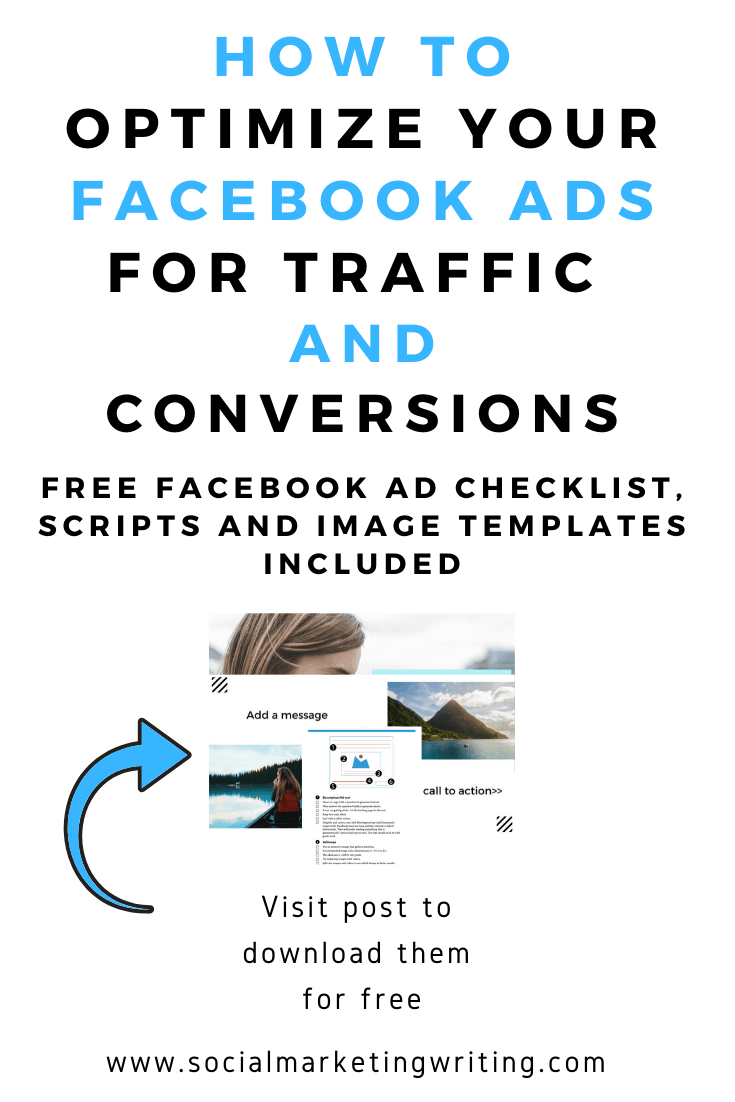It includes Facebook ad templates, 12 ad scripts and a visual checklist.
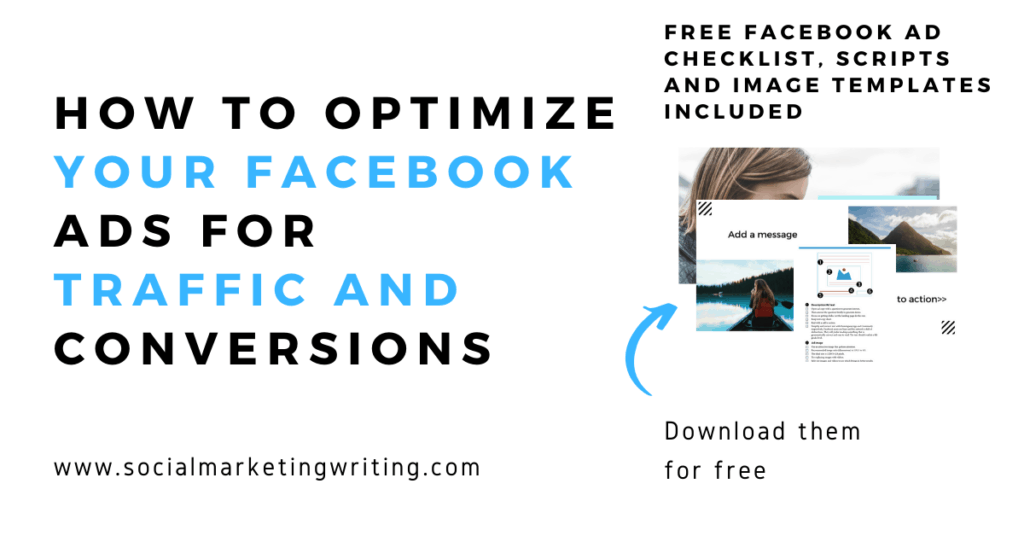
Do you want to create Facebook ads that generate traffic and conversions? Do you want to generate maximum ROI for your spend?
The point of any ad campaign is to drive traffic and generate leads or sales. If the conversion rate of your campaign is not optimized, you will generate a poor ROI.
In this article, we will be concentrating on the steps you should take to optimize the traffic and conversions from your Facebook ads.
When it comes to social media advertisements, Facebook is one of the best platforms for marketers. With over 2.38 billion monthly users, Facebook can be a very useful tool for lead generation.
Among all the social media platforms, Facebook ranks the highest for driving conversions.
Investing in ads will speed up the process and help you drive more conversions quickly.
Before we proceed into the strategies, note that conversions are not all about a customer making a purchase. A conversion occurs when the desired action is taken.
Depending on the reason for your ad campaign, a conversion can also be any of the following:
- Getting signups to a webinar
- Growing your email list
- Increasing awareness for a brand, etc.
With that at the back of our minds, let’s dive into the strategies you can use to optimize your Facebook ads for traffic and conversions…
1: Target the right audience
For every marketing effort, whether it is content marketing, social media marketing or paid media advertisements, the first and crucial step to take is locating your target audience.
Without knowing your target audience or if an audience even exists for the service you are selling, you cannot realistically expect your Facebook ad to generate any serious leads.
The more you understand your target audience, the more efficiently you can focus your reach on individuals who need your services and will convert easily.
Who is your target audience?
Your target audience is the specific group of people that you want to reach with your marketing efforts. They are the set of individuals that need your products and are more likely to spend money on purchasing them.
You can use these steps to effectively execute Facebook audience targeting.
Make use of live event targeting
Facebook ad manager has a tool that allows targeting an audience based on situations that are happening in real life. This will allow you to target people based on experiences that they are having at that point in time.
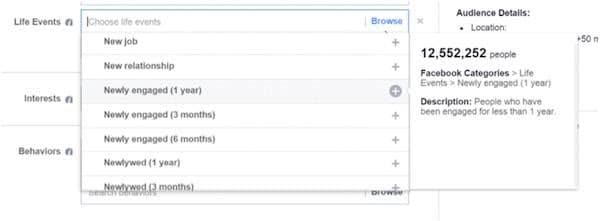
For example, a company that sells baby diapers will be interested in nursing mothers. So they will target women that just gave birth or women with kids between the ages of 0 – 3 months old.
If they instead target just “women”, they will be losing a lot of revenue on ads that won’t convert. Not all women are in need of diapers. Targeting a female audience that needs diapers will lead to more conversions.
Create Facebook custom audiences
This is an advanced feature on Facebook that allows you to show ads to an existing customer list.
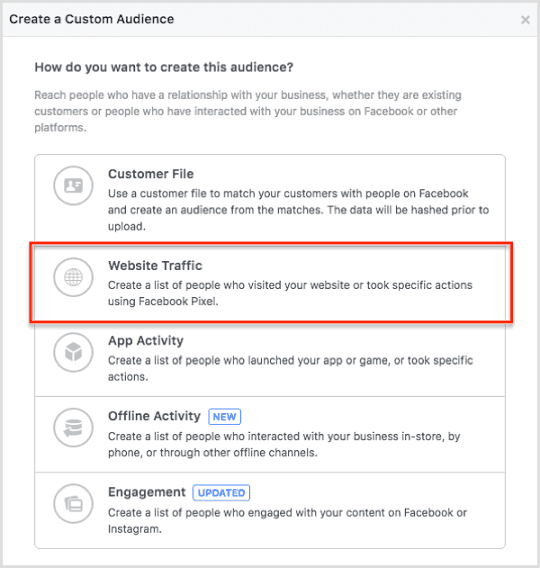
Getting your ads in front of an existing audience is one of the easiest ways to ensure a high ROI.
This works in another way also. For example, if you have a product and are looking for new users, you will not want your existing customers to see an ad for this product. Exempting them from seeing the ads will avoid wasted clicks and increase the ROI of your click-through rate.
Branch out using a lookalike audience
If you have already optimized your custom audience list, the next step will be expanding to a lookalike audience.
A lookalike audience allows you to expand your reach by targeting profiles that are similar to your custom audience or targets.
You can still do this even if you do not have an email list or a huge fan base. As you can use the Facebook Pixel tool to create a website custom audience that you can mirror.
After deciding on which audience you want to mirror, you can either make your reach broader by expanding or smaller by making it specific to your audience.
Bonus: Click Here to Download the Perfect Facebook Ad Design Toolkit!It includes Facebook ad templates, 12 ad scripts and a visual checklist.
2: Create a killer landing page
Your Facebook ad is only as effective as your landing page.
While optimizing your Facebook ads to reach the right target audience, it is important that you are directing them to a landing page that is optimized for conversions.
These are some of the best practices for a killer landing page:
Write simple clear headlines that grab the visitors attention
Your goal with your landing page should be to get the attention of the visitor towards what you are offering in the first few seconds of visiting your page. Keap’s landing page is a great example.
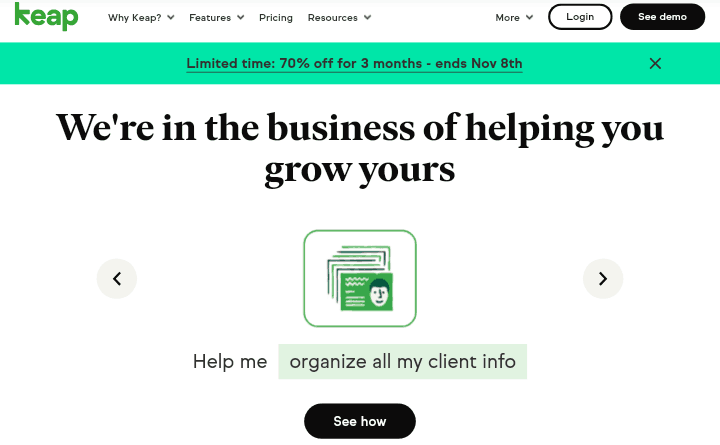
Keap’s homepage headline is short and straight to the point. Their value proposition is that they help you grow your business.
Use the right images
The content of your landing pages are important, but images can draw emotions from the visitors and drive your point home. Ensure that the images you use on the landing page are in sync with the content of your copy.
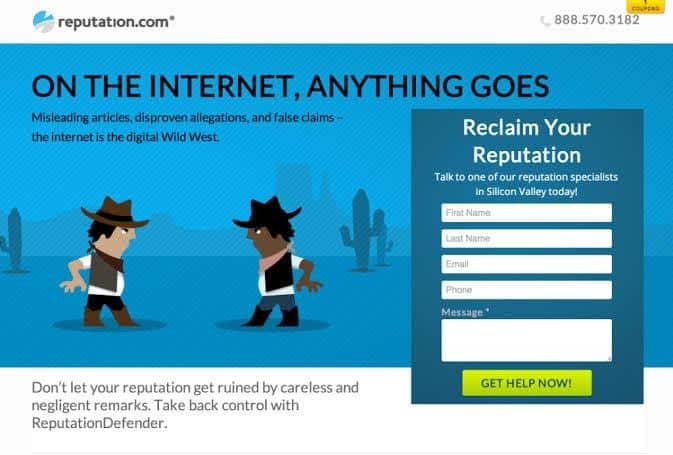
For example, this image on Reputation.com’s landing page is both compelling and passes a message.
Have a compelling CTA
Your call to action is one of the most important parts of your landing page. As it directs the customer towards taking a particular action.
These are some factors you need to optimize to create a great CTA button.
- Color: Ensure that the color of your CTA button contrasts from the background of the page. Research shows that the best CTA button colors are red, orange, and green. While the worst colors are black, white, and brown.
- Size: The size of the button should not be too small that the visitor has a hard time finding it, or too big that it looks intimidating.
- Messaging: Your CTA should instill a sense of urgency and make the visitor want to take the desired action.
For example, this CTA button from Wishpond gets the job done.
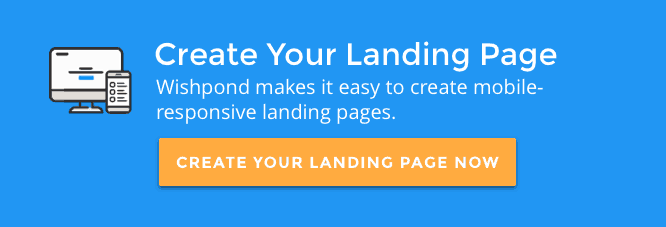
Optimize the loading times of your page
No matter how optimized your landing page is, it will be a waste if it doesn’t load fast. Your landing page needs to load within seconds or you will lose a ton of visitors.
You can use Google page Insights to analyze your page speed and see which areas you need to make improvements on.
3: Use the right ad format
Depending on your campaign goals and the audience you are targeting, it is important that you choose the right ad format.
For example, MVMT watch brand determined that carousel and video ads are the best ad format on Facebook and Instagram to increase and drive online sales during the holiday season.
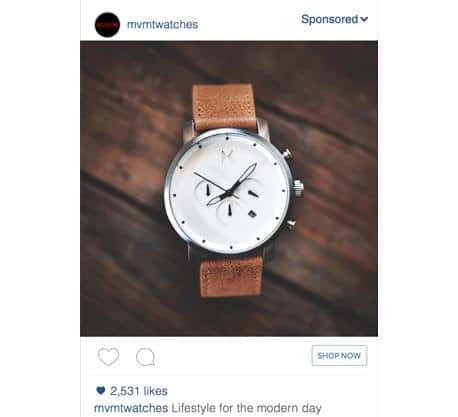
The result of the ad was that they saw a 2X higher engagement and 75% stronger brand awareness when compared to other channels.
These are some of the most popular Facebook ad formats:
Facebook photo ads
For people to engage with your ads, it is important that you have a high-quality engaging image. This kind of ad has an image with a compelling caption.
To make your Facebook image ads great, tick the following boxes:
- Create a compelling caption
- Use high-quality photos
- Ensure that your image has little or no text. Studies from Facebook show that images with less text perform better.
- Avoid using too much text in your ad caption.
- Minimum image height and width should be 600 pixels.
Create the photos for your ads can seem complicated, but it’s easy as there are several Facebook post templates that can simplify this process.
Facebook video ads
In an earnings call, the COO of Facebook, Sherly Sanberg, announced that “For businesses, winning on mobile means winning on video”.
Research shows that users spend 5 times more time on video content than text. So you can use video to increase engagement, reach, and conversions.
Some things to note when doing video ads:
- The thumbnail image of your video should draw attention.
- Most users will decide if they want to keep watching a video after an average of 1.7 seconds. That’s how long you have to get their attention
- Your videos should be short and compelling.
- Upload high-resolution videos
- Optimize your videos for mobile users
Facebook carousel ads
If you want to feature different products at once or want to tell a story, carousel ad formats are the best option for you. You can implement both image and video ads that users can swipe through.
Some useful tips when using carousel ads:
- Use high-quality images that compliment each other and tell a story.
- Ensure that you put the images or videos in the right order so that you don’t confuse the user.
- Be creative
- The image types supported are jpg and png.
Facebook stories ads
Stories are becoming a popular template in social media platforms. Stories are full-screen images or videos that disappear 24 hours after they are uploaded.
According to Facebook, this is one of the fastest-growing ad format. So it’s worth checking out if you haven’t started using it yet.
Note that you cannot create stories ads as a standalone Facebook ad format. You can include it under placements when you select automatic placements.
You will also need to use an objective that can support stories. These objectives include reach, traffic, app-installs, brand awareness, lead generation, and video views.
Facebook Messenger ads
Facebook messenger should be an important part of your ad strategy. As it has more downloads than Facebook itself.
The best way to set up messenger ads is by using automatic placements. The ads will show up in the message inbox of the user and it can be in the form of video, image carousels or dynamic ads.
4: Optimize your ad schedule
To increase the conversions of your Facebook ads, it’s important that you schedule your ads on the days your target audiences are most active online.
Some days work better than others, while some hours in a day will generate more engagement than others.
To analyze what time/days your ads have the highest engagement rate, make use of the Facebook Manager Ads report.
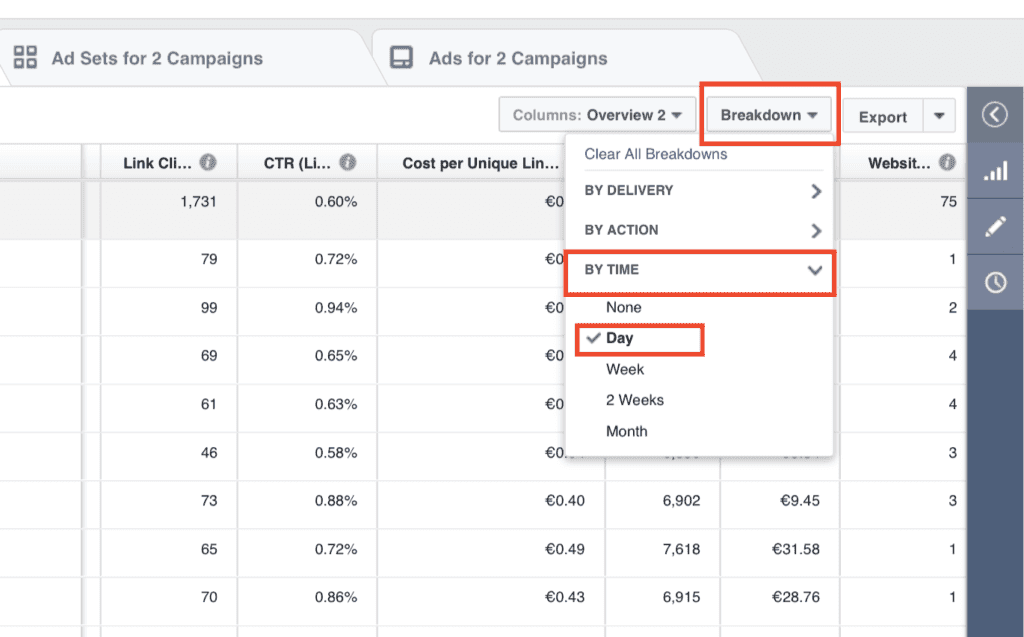
This report will give you a break down of when your ads are performing optimally so that you can create a custom schedule to target these times.
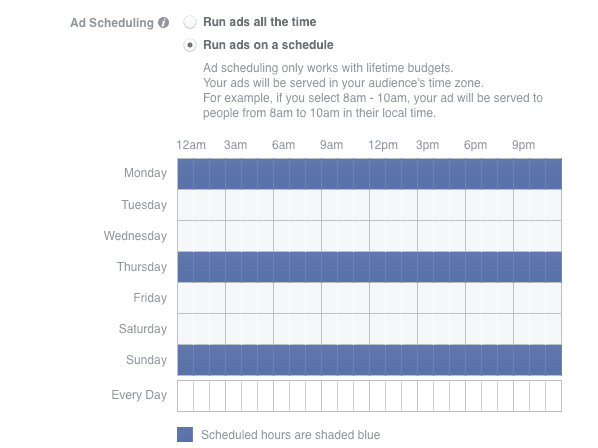
Targeting these times will ensure that your target audience gets to see your ads thereby improving conversions and engagement.
5: Optimize the placement of your Facebook ads
Research by AdEspresso shows that the placement of your ads can affect your cost per clicks (CPC’s) by up to 550%.
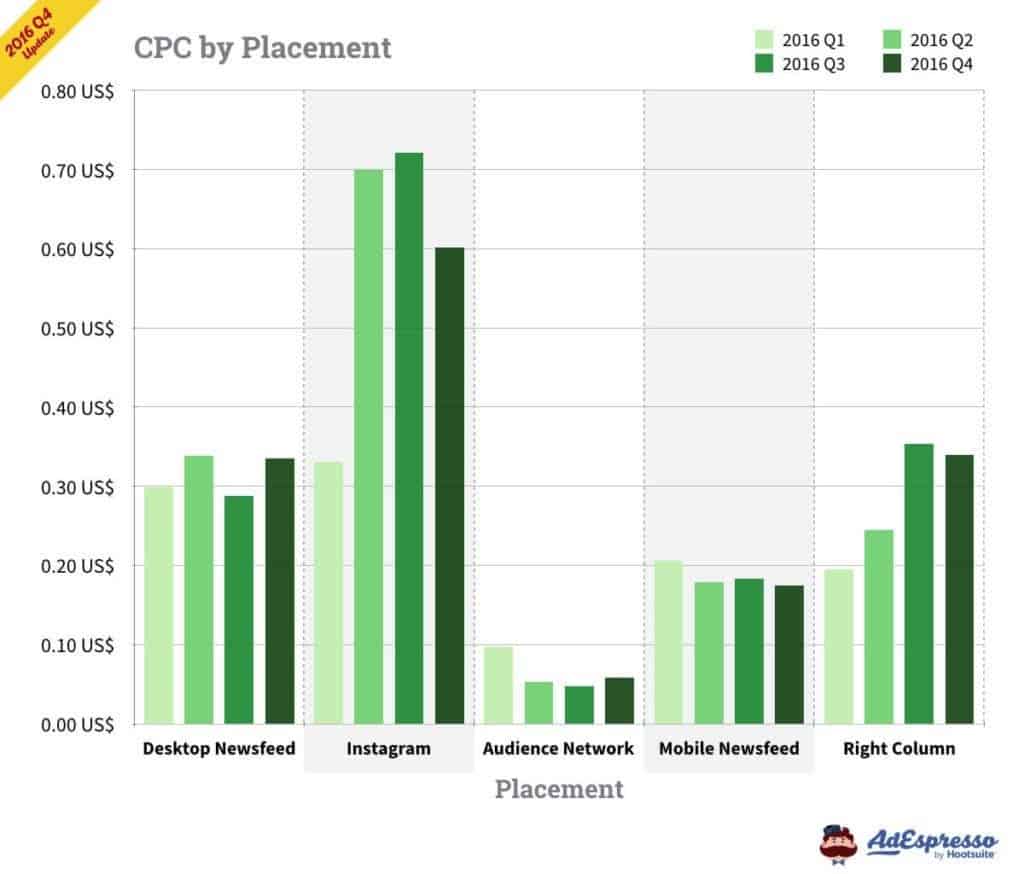
The various Facebook ad placements include :
- In-feed: Your ads will appear in inboxes, desktop or mobile feeds.
- Stories: Full-screen ads will appear in users stories
- In-stream: These ads appear as short videos during or after video content.
- Search: Your ads will appear in the Facebook search results
- Messages: Your ads will appear as sponsored messages to people who are already in an existing conversation with you.
- In-article: Your ads will appear within Facebook articles in the mobile app.
- Apps and sites: These ads appear on external sites or apps. The apps may appear as a banner, reward videos or in-stream videos.
To discover what type of ad placement works best for your audience, you can see a breakdown in the Facebook Ads manager by checking your campaigns by placement.
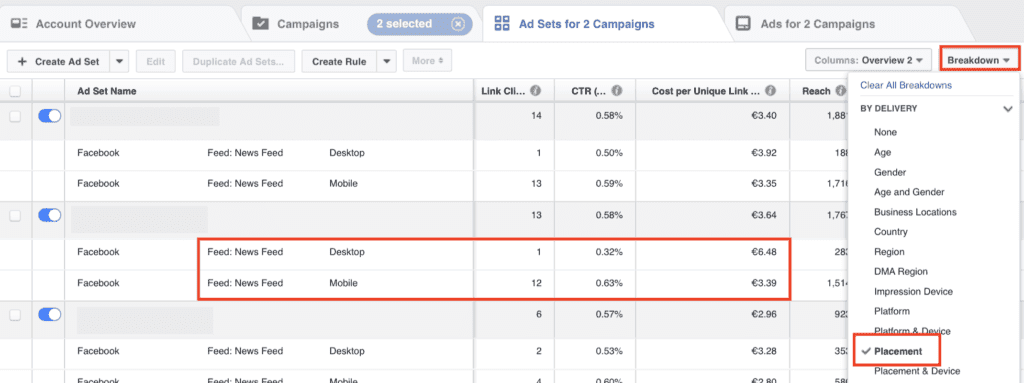
You can also use Facebook Ads Library to analyze past ad sets and determine the most effective targeting options and ad formats for your target audience
6: Choose the right campaign objective for your ad
When setting a new Facebook ad campaign, you will need to choose a campaign objective.
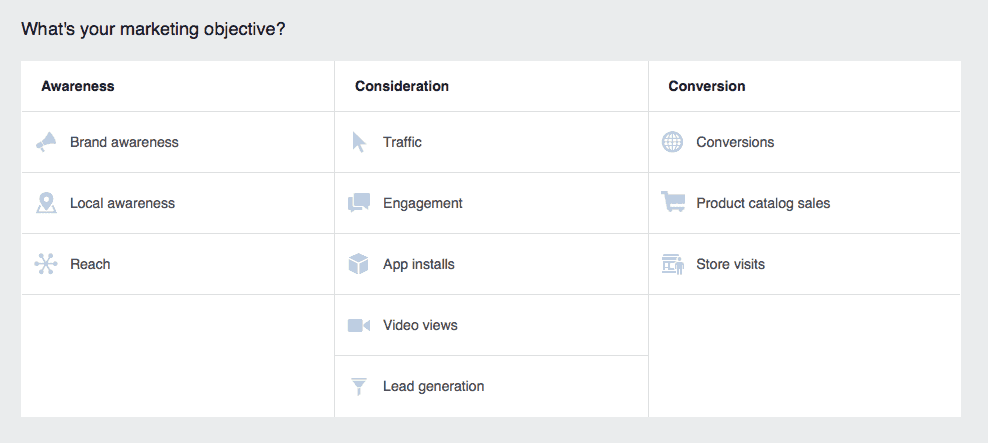
Your campaign objective tells the Facebook algorithm what the purpose of your campaign is to ensure the best delivery.
Choosing the right objective makes it easy for Facebook to auto-optimize your campaigns and determine the cost-per-delivery of your ads.
Always choose the right objectives so that Facebook can optimize your campaign depending on your advertisement goals.
For example, if your goal is to increase traffic, choose the “consideration” objective.
7: A/B test your ideas to find out what works
The key to optimization is performing regular A/B testing.
To ensure that your ads are optimized, run regular A/B tests. These are some of the things you should test:
- Ad copy. Test all of it, especially your headline
- The design of your ads
- Call to action. Including the color and the statement
- Your unique value proposition
- Ad placements
- Ad formats
- Campaign objectives
- Bidding methods.
Conclusion
Optimizing the traffic and conversions your Facebook ads generate involves a lot of testing. The tips mentioned in this article should help you get started quickly. So, begin implementing them today
When your Facebook ads are optimized, not only will you improve conversions, you will also see an improvement in lead generation, user engagement, click-through rates, and a higher ROI.
Bonus: Click Here to Download the Perfect Facebook Ad Design Toolkit!It includes Facebook ad templates, 12 ad scripts and a visual checklist.
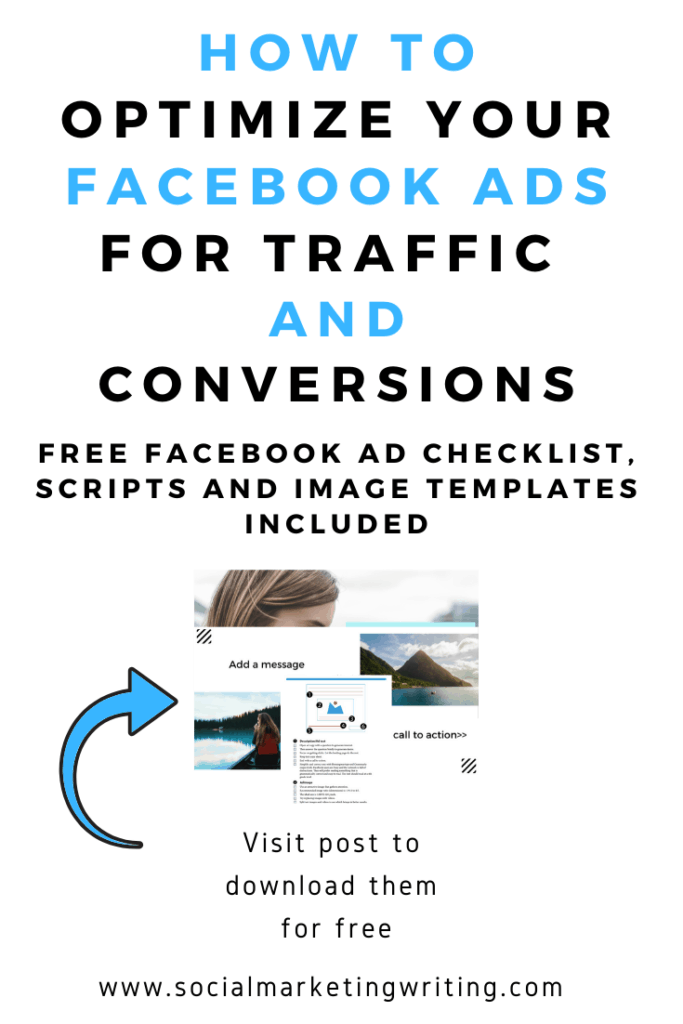
If you find this post on optimizing Facebook ads for traffic and conversions useful and feel your followers will too, please share it with them by using the share buttons.
About Marvellous Aham-adi
Marvellous Aham-adi is a freelance writer and content marketing strategist. He writes on how to grow a startup, marketing, and optimizing productivity at thezeroed.com. He has also been featured in top publications like Social Media Examiner, SocialPilot.co, and OnCrawl.
